In a recent survey, over 70% of engineers and almost 50% of programmers revealed that the writing quality in their jobs was either “very important” or “extremely important.”
One way to ensure that writing is up to standard is to employ a technical writer—someone whose sole task is to create and take care of all technical documentation.
The question is, how to become a technical writer? After all, you’ll rarely find a college course training students for this profession.
Don’t worry; we have you covered. This article will walk you through five skills good technical writers should have.
Good Grasp of Technical Writing Tools
Technical writing is not just writing.
The profession encompasses many other processes: a technical writer researches, organizes materials, creates visuals, edits, reviews, and publishes.
These aspects of the job all require different tools. In general, the types of tools can be divided into the categories depicted below.

Source: Archbee
Given the scope of the process, there are numerous tools that writers can use to deliver high-quality technical writing.
The most common spell-checker is Grammarly, whereas Microsoft Word and Google Docs are classic authoring tools. When it comes to image editing, Adobe Photoshop first comes to mind.
Screenshots are valuable resources for technical writers as they help visualize the written content. Snagit is a popular choice.
You can use this gadget to take screenshots of drop-down menus and specific scrolling areas, as well as record videos.
The tool can also embellish the screenshots with arrows, circles, and frames.
You can even blur out text and combine multiple screenshots in one image. The video below will better illustrate the editing procedure.
Source: TechSmith on Youtube
Another helpful tool for publishing your writing is Markdown. This resource allows you to write in plain text and then automatically converts it to XHTML or HTML.
The syntax is nothing fancy (just basic formatting), making it accessible to most, and there are multiple customization options (layouts, sizes, colors, etc.).
Markdown editing is also available as part of the Archbee online documentation platform.
Archbee is the go-to solution for maintaining knowledge bases and other company documents, and its Markdown shortcuts make for snappy editing and greater readability.

Source: Archbee
Archbee’s main appeal for technical writers are its API capabilities.
The software’s extensive API integration enables you to import API reference information via an OpenAPI file, which then embeds a Swagger-UI-esque user experience.

Source: Archbee
GraphQL is also supported, and there’s also an Endpoints widget for communicating documents with API specifications (sans OpenAPI).
Aside from the API goodies, there is also a code editor block, where you can add multiple tabs using the same language.
The tabs can later be renamed as a file, such as main.js, pictured below.

Source: Archbee
The strong support for writing code and API documentation and code, as well as its integration with conceptual and task-based content, make Archbee an excellent tool for technical writers.
Research Skills
By definition, technical writing is objective and fact-driven—recording technical specifications has to be.
As a result, you’ll have to research to ensure the intelligence you’re communicating is 100% correct.
It’s not unusual for technical writers to be writers first and technical second, in which case the first step is to learn everything possible about the product.
This is especially true for outsourced technical writers, who constantly write for new clients and products.
Perhaps the easiest way to provide technical writers with the information they need is to keep all relevant intelligence in an internal knowledge base.
By uploading everything to a shared platform, technical writers have the bulk of their resources in one place and can easily navigate the information at their disposal.
An example of a knowledge base is pictured here.
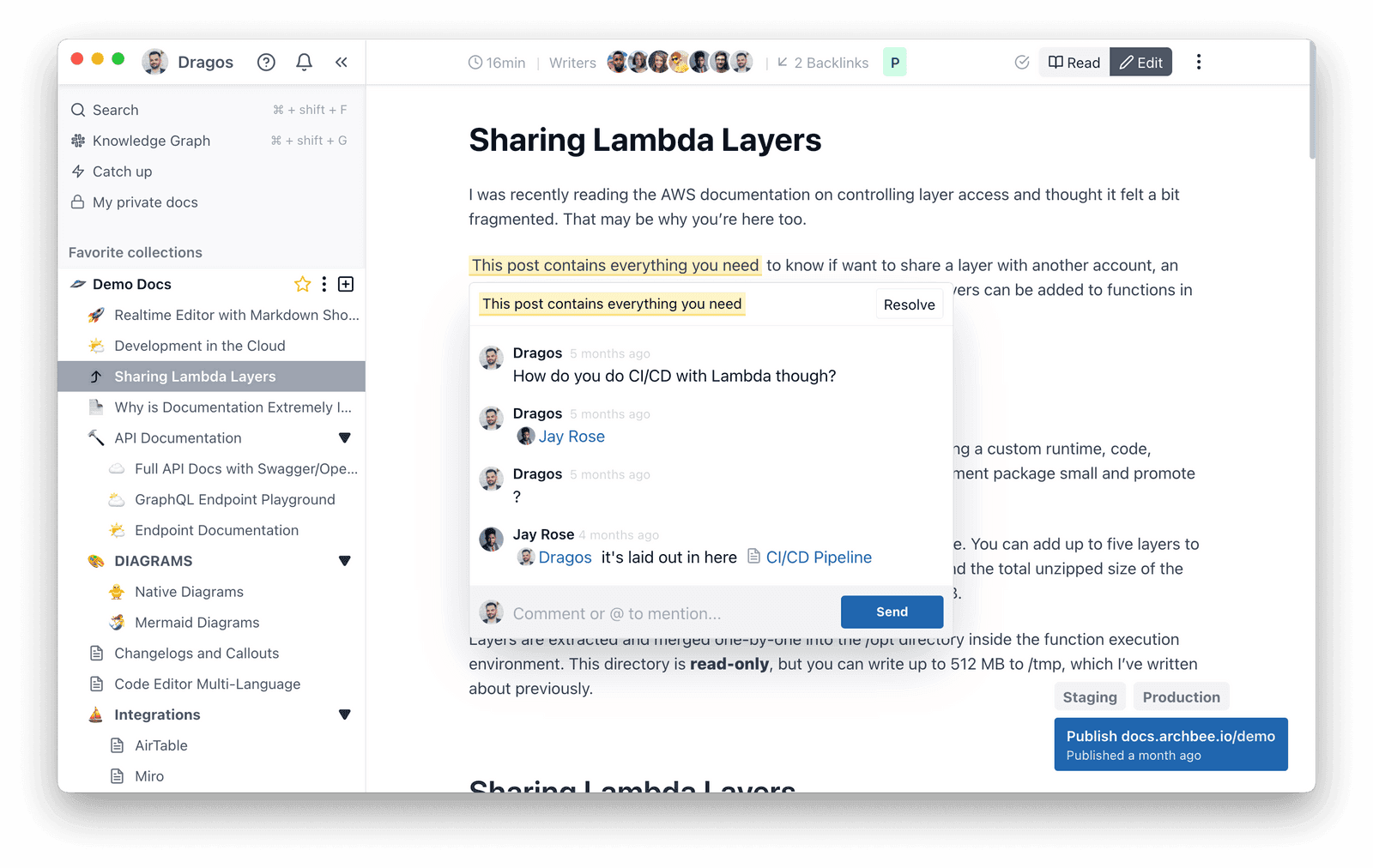
Source: Archbee
Even if you have to do further research, at least you have a solid starting point. Furthermore, in case you have to add to the existing metrics or edit any information, this is easily done in a knowledge base. When using Archbee’s knowledge base, you can even start an asynchronous communication thread with co-workers.
Besides straightforward data analysis, there are two other research types: Audience Analysis and User Experience. All three are elaborated on below.
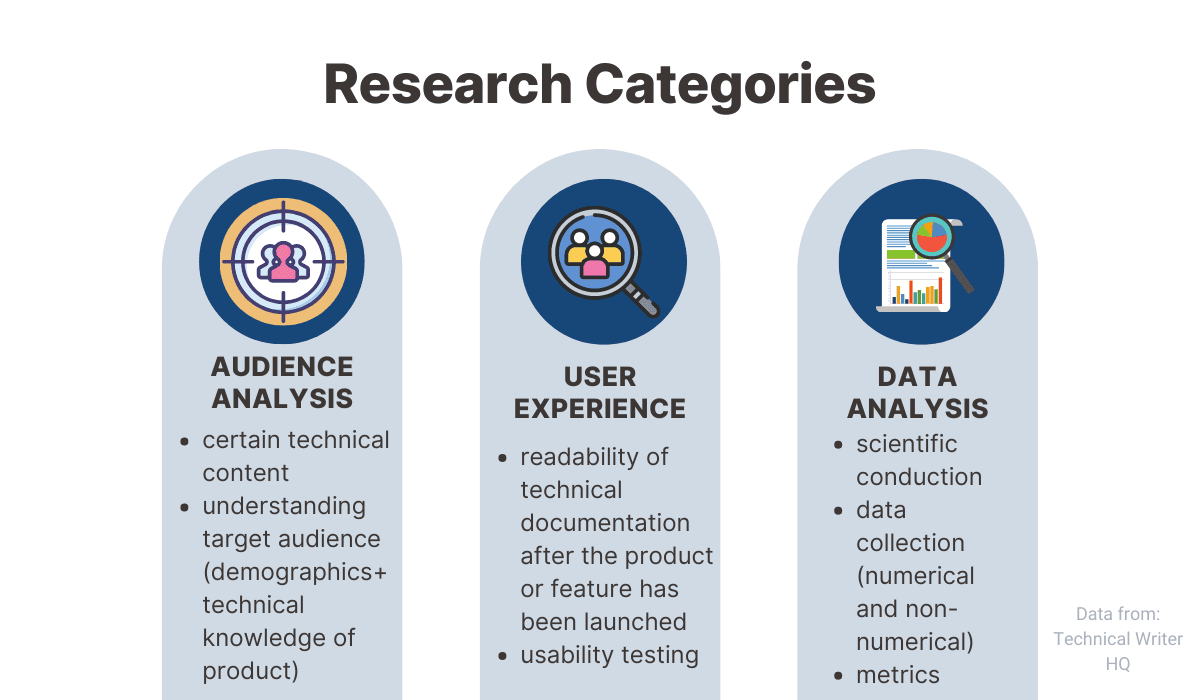
Source: Archbee
As explained, technical writers must also consider their audience and user experience.
When researching user experience, writers test the readability of the finished technical document and determine if the product is easy enough to understand for target users.
Audience analysis is about assessing the target audience and determining their needs, interests, and overall level of technical knowledge related to the product.
Writers adjust their style and tone to appeal to their target audience.
An expert in technical writing also commented on this in a Quora thread.

Source: Quora
As demonstrated, it’s essential to keep your audience in mind, as who you’re writing for can radically change your approach.
Once you know your audience, a good research tactic is formulating a list of questions your readers will want answered—these will serve as guidelines for your writing.
For example, let’s say you’re compiling a user guide for a microwave. Some sample questions your audience might ask are:

Source: Archbee
And so on. By putting yourself in your audience's shoes, you’re already narrowing the scope of your research and collecting the correct answers.
Being Systematic
Technical writing can perhaps be best described as translating difficult, complex concepts into understandable, easily-digestible content.
Part of making such texts readable is being thorough—having all the information laid out in an orderly, organized manner.
If your document has a clear structure, it is easier for your readers to absorb the information. This skill is called information architecture.
It refers to the art of organizing and labeling content effectively and efficiently.
Possessing such a skill is invaluable for good technical writers, as it makes their documents much more accessible.
One example of architecture technology is the 10/100/1000 rule, explained in the Reddit thread below.
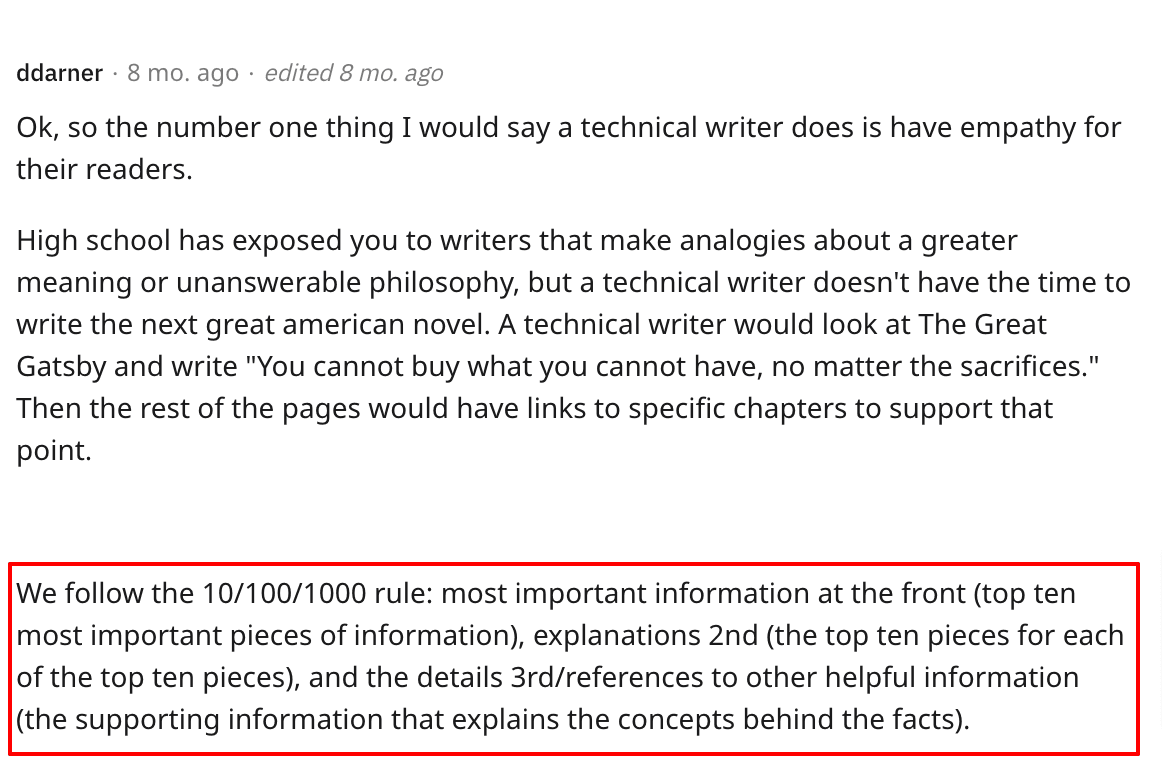
Source: Reddit
This type of information architecture is intuitive and self-explanatory, ensuring that readers receive the most crucial information.
In addition to having the finished documentation organized, it’s also a good idea to be systematic in the writing process itself.
By following an established writing procedure, you can apply it to almost any document you create. That way, each piece will have an identical structure.
Designing one standard workflow should also increase your speed and efficiency, as you get more and more used to writing that way.
Although technical writers cover varying topics, there are often common threads of information for each subject matter.
This is precisely what allows a technical writer to devise a systematic approach. See below for possible questions that can be asked for almost every topic.

Source: Archbee
Regardless if you’re writing documentation for software usage, R&M (Repair and Maintenance), or engineering instructions, all of the above questions are applicable for technical writing; they can help be the foundation for a systematic writing approach.
After you’ve answered your questions, a mind map can help you organize and structure those answers.
A mind map is helpful as you can build relationships and links between your various pieces of information, creating a clean visual overview of what the document should look like.
MindMeister is a fantastic resource for creating your mind map; the video below will explain how to use this tool.
Source: MindMeister on YouTube
In addition to the standard mind map features, you can also write comments to start discussions with others and embed media (images, videos), which helps you add context to the ideas.
Writing Skills
This might be a no-brainer, but it has to be said—a technical writer should have excellent writing skills.
Technical documentation is often complex, and a clear writing style goes a long way toward making this intelligence readable.
Having an innate talent for writing helps, but certain characteristics improve the text’s legibility.
These qualities are markedly different from the usual ideals of creative writing, so it’s worth noting the differences.
The visual below provides a general overview.
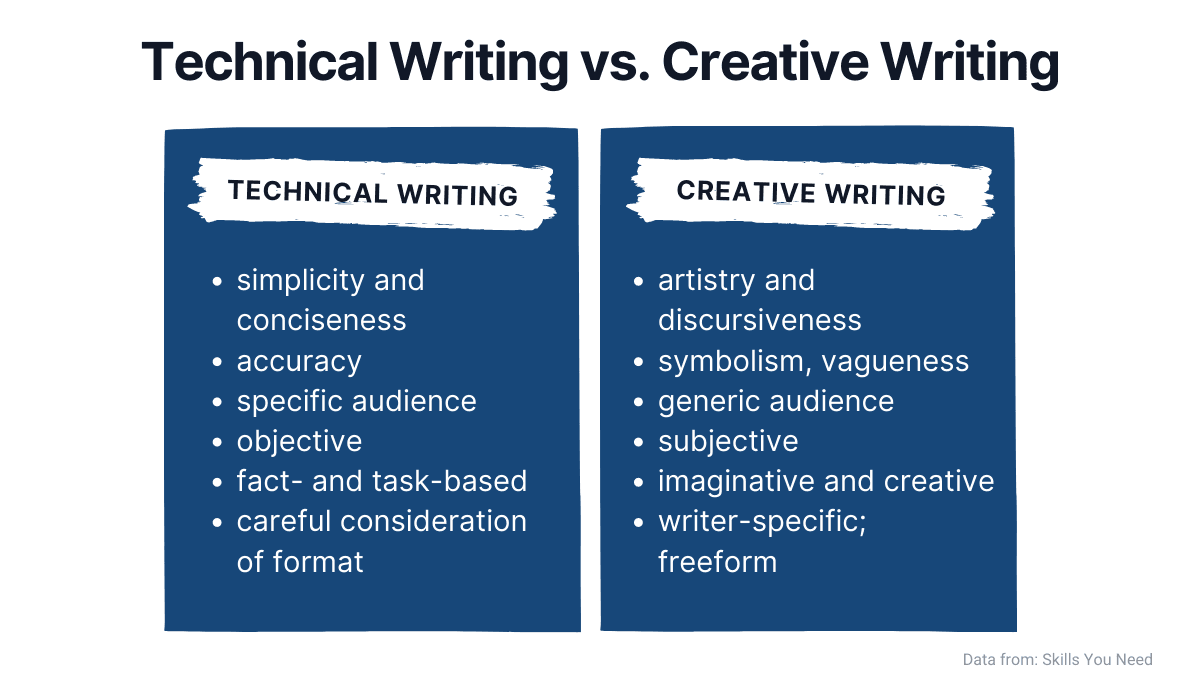
Source: Archbee
As you can see, the style technical writing requires is markedly different from creative writing.
Technical writing should be fact-driven and objective. It attempts to convey a lot of information as briefly and clearly as possible.
To achieve this succinctness, pay close attention to your sentence structure. Re-read your sentences after writing them, and ask yourself if there are any unnecessary words.
Anything superfluous, any word without which the statement retains its original meaning, can be thrown out. You want to keep your writing short and simple—that’ll get the point across best.
Another hack is to write in the active voice, avoiding the passive wherever possible.
The active voice tends to make a text more alive and engaging, easily grabbing the reader’s attention.
William Zinsser mentions the same points in his classic guide On Writing Well:
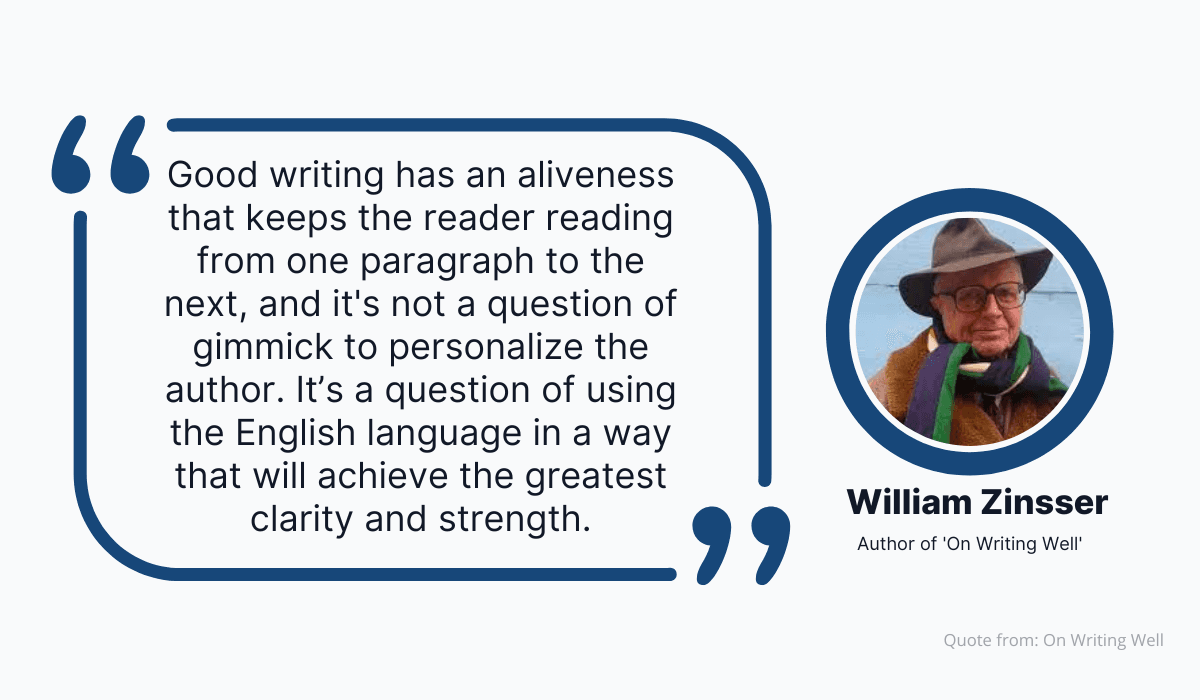
Source: Archbee
If you can achieve the tone described above, you’ve got your writing skills up to standard, and your documentation will be clear as day.
If you’re not sure about how to improve these skills, there are plenty of online courses that can help you out.
Udemy has more training sessions than you can count, so you’re sure to find the niche that you need.

Source: Udemy
These online courses can go a long way in bettering your technical writing skills, and they often include extra material such as downloadable articles and additional resources to make the learning process easier.
Below is an example of a good piece of writing.

Source: Archbee
This brief text explains what the widget is for, its features, and provides a step-by-step checklist.
Readers can tell in a heartbeat if this is something they need (especially product-led and developer-facing companies).
If it is, there are clear instructions for integrating the widget. It is to-the-point yet packed with all the necessary information.
Communication Skills
Interestingly, technical writers tend to come from an English/Literature education instead of a technical background. The visual below shows the breakdown of technical writers’ education.
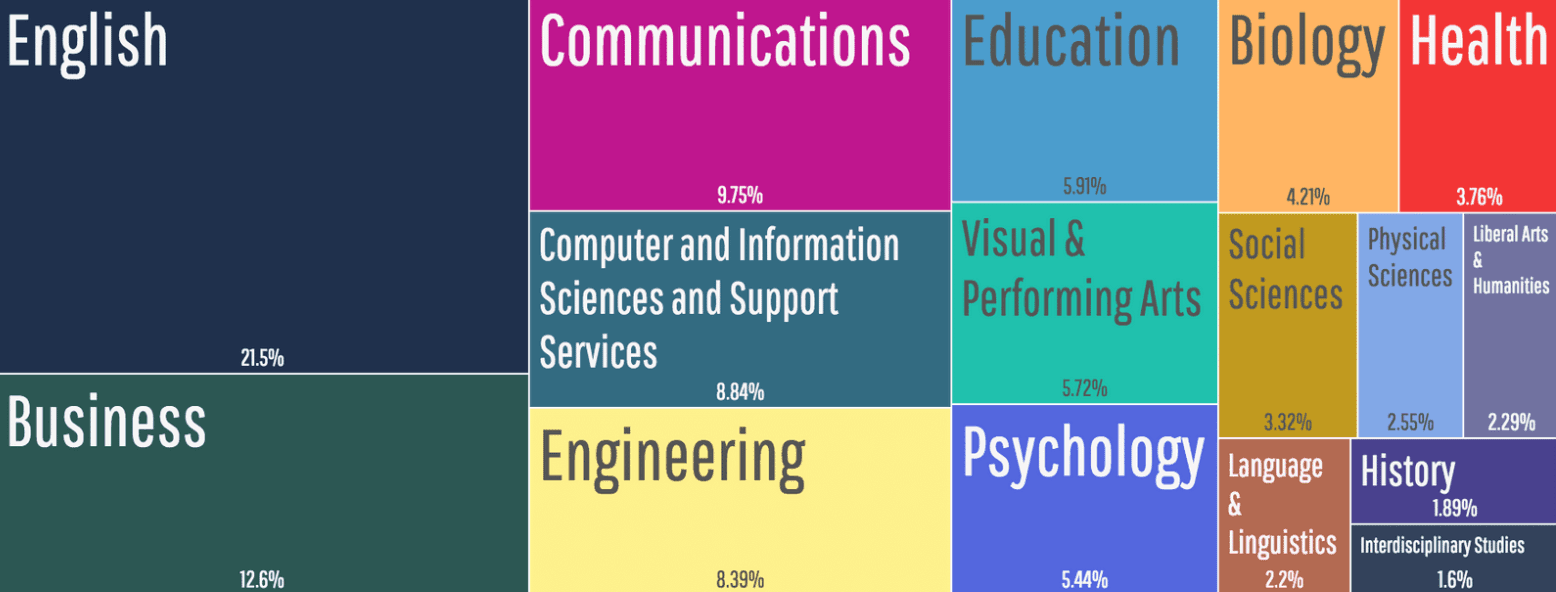
Source: Data USA
The IT field ranks fourth, well behind English.
This means that technical writers often aren’t 100% familiar with the product they’re documenting and will need to consult with developers, engineers, and designers to acquire the necessary information.
For this type of teamwork, good communication skills are a must.
When meeting with SMEs or product owners, practicing active listening is highly recommended.
This essentially means closely engaging with your interlocutor, asking them questions, and rephrasing their statements to ensure you’ve understood everything.
Passively listening isn’t a good idea, since that way you won’t be able to clarify information, which could result in misunderstandings.
Nonverbal communication is another helpful skill, as you can use your body language to show respect and welcome your colleague into a conversation.
For example, don’t cross your arms, as this makes you seem closed-off and unapproachable.
Instead, keep them relaxed, at your sides, to communicate openness. Similarly, use your facial expressions to convey respect, gratitude, and understanding.
These small gestures can go a long way, and the SME should realize your appreciation for their assistance.
It goes without saying that these interviews are most valuable when recorded or heavily transcribed; you will need to have some notes to lean on when writing.
These memos can be a life-saver later, as an experienced writer attests to in the screenshot below.

Source: LinkedIn
Having rich visual or written materials helps with writer’s block and organizing your thoughts, so make sure you have some records to fall back on.
Another communication method for gathering information is to send a content request form. This form will ask for basic information, such as the goals, target audience, due date, and length.
With this form fully filled out, you’ll have a quick reference point when composing the documentation.
It’s also a superb method of managing multiple projects at once, as you’ll have an overview of your tasks at a glance. DIVVY is a good tool for this, pictured below.
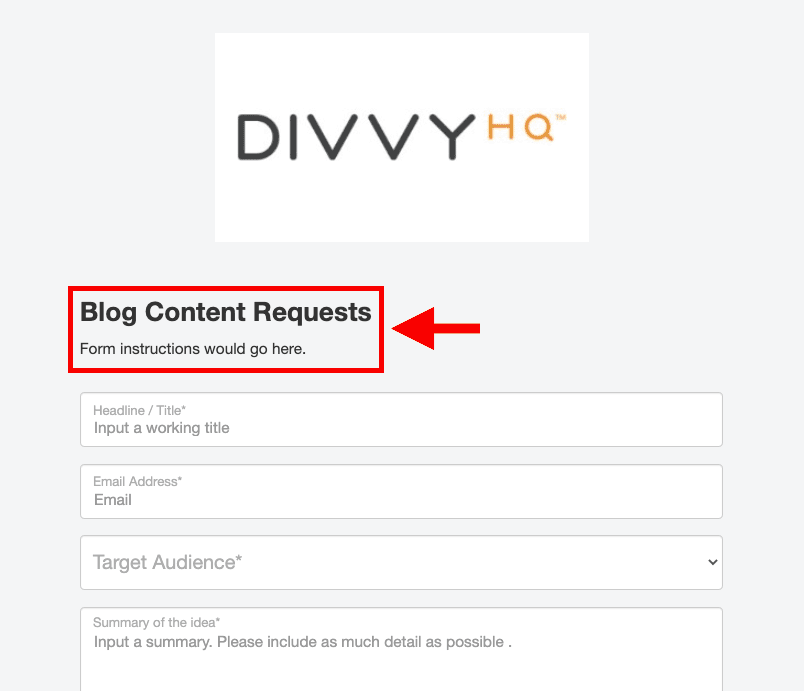
Source: DIVVY
This is a simple sample content request form, and whomever you send it to can then complete all the relevant details; think of this form as a springboard for your next project.
Conclusion
A technical writer’s main task is to translate specialized, practical information into laypeople’s English.
To do this, you’ll have to combine several skills to produce a clean-cut, easily-readable document.
Excellent writing and communication skills are must-haves, but it is also vital that you’re able to conduct research.
A systematic approach is a huge help, and it’s also highly suggested to be familiar with several technical writing tools.
By mixing all of these skills, you have the perfect recipe for a well-written, comprehensible, thorough, organized, and modern document.
We hope we’ve helped guide you in the right direction!
Try Archbee's full range of features with our free 14-day trial.
Frequently Asked Questions
Five skills consistently show up: 1) Tool proficiency: knowing how to research, write, illustrate, and publish with the right software. 2) Research: verifying facts, learning the product, and understanding the audience and their context. 3) Systematic thinking: structuring information logically (information architecture) and following a repeatable workflow. 4) Clear writing: concise, accurate, active-voice prose that makes complex topics easy to follow. 5) Communication and collaboration: interviewing SMEs, asking smart questions, and coordinating feedback across teams.



